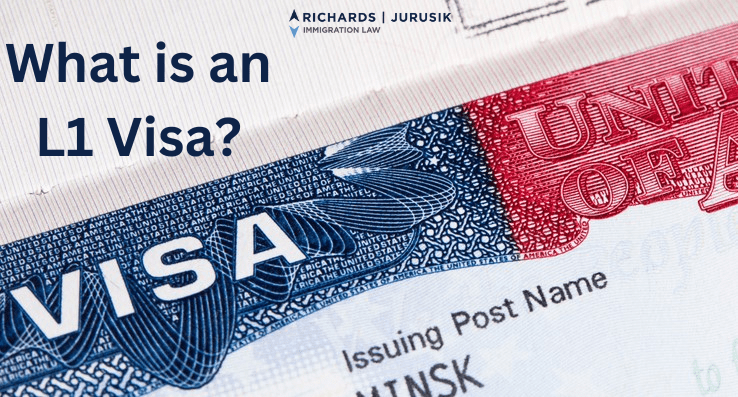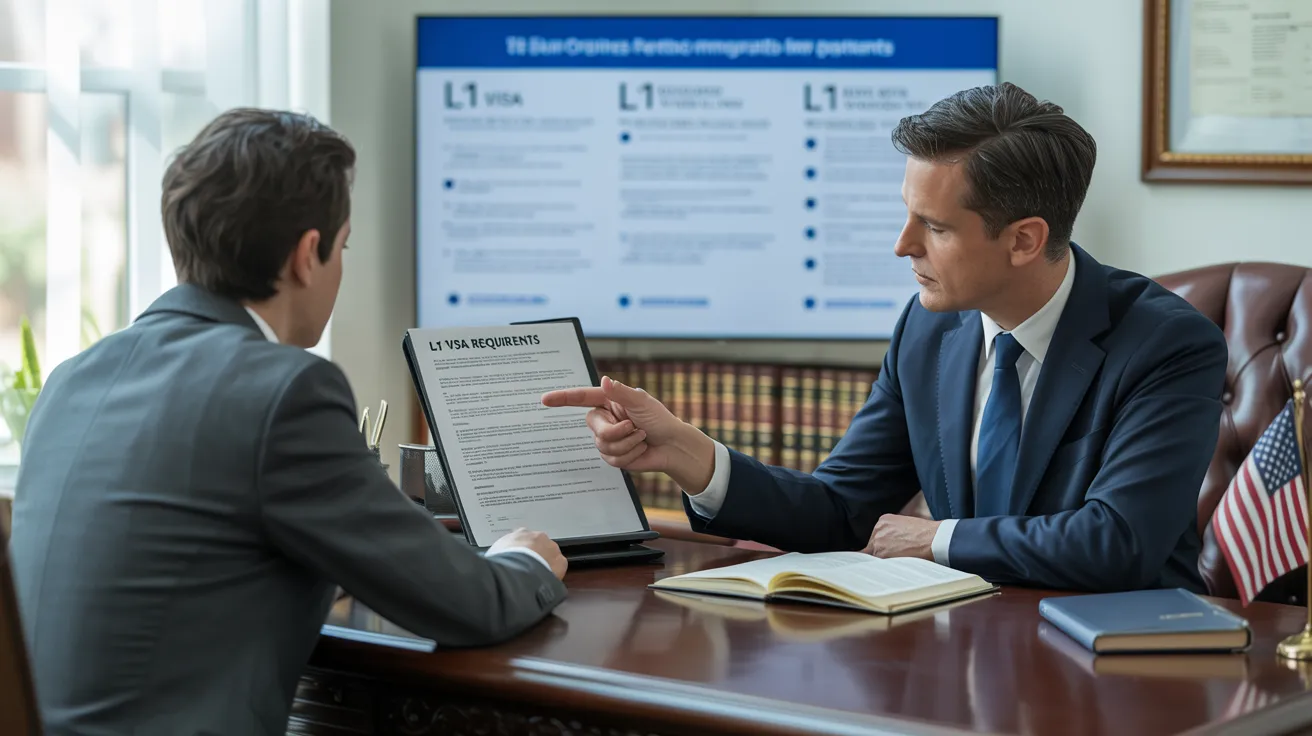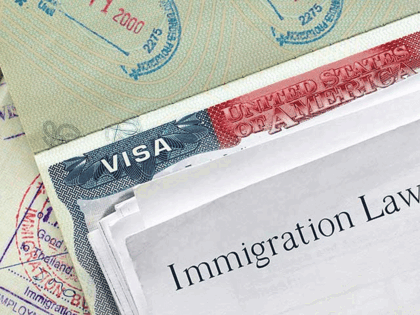Unlocking Opportunities: A Comprehensive Overview to the L1 Visa Process
The L1 visa procedure provides a crucial pathway for international companies seeking to transfer crucial staff members across borders. Understanding the subtleties of eligibility criteria, the distinctions between L-1A and L-1B visas, and the details of the application procedure can greatly affect a candidate's success. Steering this facility landscape is not without its difficulties, and careful interest to paperwork and company sponsorship is important. As we discover the crucial components of this procedure, the approaches for getting over possible obstacles will certainly come to be apparent, disclosing how informed prep work can open up a world of chances.
Comprehending the L1 Visa
Comprehending the L1 visa entails recognizing its value as a crucial tool for multinational firms looking for to transfer experienced staff members in between international offices. This non-immigrant visa group helps with the motion of execs, supervisors, and specialized expertise employees to the USA, therefore enabling organizations to maintain functional continuity and harness worldwide ability successfully. The L1 visa is separated right into 2 main categories: L-1A for managers and executives, and L-1B for staff members having specialized knowledge.The L1 visa serves a crucial role in improving a business's one-upmanship in the international industry - L1 Visa Requirements. By enabling firms to relocate their key employees, companies can assure that vital jobs are taken care of by qualified people that are already aware of the company's society and functional procedures. This internal transfer system not only promotes expertise sharing yet also promotes technology and collaboration throughout borders.Moreover, the L1 visa is commonly preferred for its fairly straightforward application procedure compared to various other visa categories, as it enables dual intent, allowing owners to seek long-term residency while on a short-lived copyright. This attribute makes the L1 visa especially appealing for both employers and workers, as it simplifies the pathway for competent specialists to develop long-term residency in the United States
Qualification Requirements
Eligibility for the L1 visa depends upon a number of essential requirements that assure both the worker and the company satisfy particular certifications. This non-immigrant visa is created for multinational business to transfer staff members from foreign offices to U.S. counterparts.Firstly, the employer has to be a qualifying company, which consists of a moms and dad company, branch, affiliate, or subsidiary of an U.S. company. The company has to have been doing company for at the very least one year both in the united state and abroad. This assures that the firm has sufficient functional stability and a reputable presence.Secondly, the worker has to hold a supervisory, exec, or specialized knowledge position. For L1A visas, the applicant should show managerial or executive certifications, while L1B visas concentrate on specialized understanding pertaining to the company's items, solutions, or procedures. Furthermore, the staff member must have benefited the international entity for a minimum of one continual year within the last 3 years prior to their application.Lastly, the staff member's function in the U.S. must straighten with their previous position, making certain that their abilities and proficiency are leveraged for the company's benefit.
Sorts Of L1 Visas
The L1 visa group comprises 2 primary kinds developed to assist in the transfer of employees within international business: the L1A visa for supervisors and execs, and the L1B visa for workers with specialized expertise. Each kind offers unique objectives and has details eligibility criteria.The L1A visa is customized for people that hold supervisory or executive positions within a business. This visa makes it possible for high-level employees to move to a united state branch, subsidiary, or affiliate of the exact same company. Candidates for the L1A visa must show that they have been employed in a supervisory or executive capacity for at least one continual year within the previous three years prior to their application. In addition, this visa uses a longer duration of stay, at first granted for 3 years, with the possibility of extensions for approximately 7 years.In contrast, the L1B visa is planned for professionals with specialized knowledge related to the business's products, solutions, or procedures. To certify, candidates need to verify that their know-how is important to the company and that they have actually benefited at the very least one continuous year within the last 3 years in a role that required this specialized expertise. The L1B visa is at first given for three years, with extensions readily available for up to five years.Both visa types are crucial for business looking for to enhance their global operations by leveraging proficient workers, therefore promoting advancement and efficiency within the united state market.
Application Process
Steering through the L1 copyright process involves numerous important steps that should be meticulously complied with to ensure a successful outcome. The process starts with the united state employer, that must initially develop eligibility by showing a certifying relationship with the international entity and confirming that the staff member fulfills the details needs for the L1 visa classification being sought.Once qualification is validated, the company starts the process by submitting Kind I-129, the Petition for a Nonimmigrant Employee, with the United State Citizenship and Migration Provider (USCIS) This type has to be come with by a thorough description of the job tasks to be executed, the organizational framework of both the U.S. and foreign entities, and the worker's qualifications. It's important to confirm that all details is exact and complete, as noninclusions or mistakes can bring about hold-ups or denials.Upon authorization of the I-129 request, the next action entails the staff member looking for the L1 visa at an U.S. consular office or consular office in their home country. This stage needs the conclusion of Kind DS-160, the Online Nonimmigrant copyright, and scheduling a meeting. Throughout the interview, the applicant must provide proof sustaining their certifications and the employer's petition.After the visa is granted, the staff member can go into the United States to work in the assigned duty. In general, mindful preparation and adherence to each action of the application procedure are necessary for a successful L1 visa outcome.
Needed Documents

Vital Forms Needed
Steering the L1 Visa process calls for mindful interest to the vital types and documentation necessary for an effective application. The primary form required is the Kind I-129, Application for a Nonimmigrant Worker, which must be completed and sent by the united state employer. This kind details L1 Visa the information of the work deal and the certifications of the employee seeking the L1 Visa.Alongside Type I-129, the applicant will need to full Kind I-539 if accompanying family participants are also applying for visas. Additionally, the employer should give evidence of the qualifying partnership in between the united state entity and the foreign entity, typically requiring the submission of company papers such as posts of unification or economic statements.Moreover, it is necessary to include the L Category Supplement to Type I-129, which specifies the type of L Visa being requested-- either L-1A for managers and execs or L-1B for employees with specialized understanding. Candidates must assure that all kinds are authorized and dated appropriately, as insufficient entries can lead to delays or rejections. Effectively putting together these crucial kinds lays the foundation for a smoother L1 copyright procedure.

Sustaining Evidence Needs
Supporting documents is vital for an effective L1 copyright, as it confirms the claims made in the request. Applicants have to give an array of records to demonstrate qualification for the visa, which is categorized into 2 key kinds: evidence of the qualifying relationship in between the U.S. and international entities and evidence of the candidate's qualifications.To establish the connection, candidates must send paperwork such as business organizational graphes, financial declarations, and evidence of possession. These records confirm that the foreign firm has a qualifying relationship with the U.S. company, whether as a moms and dad company, subsidiary, branch, or affiliate.For the candidate's credentials, necessary files consist of a detailed work letter from the foreign employer, outlining the candidate's job title, obligations, and period of employment. Additionally, educational qualifications, such as levels and diplomas, need to be supplied to confirm the applicant's know-how in the relevant area.
Employer Sponsorship Files

Common Challenges
Steering the L1 visa procedure provides numerous usual challenges that candidates need to understand. Secret concerns usually include rigid documents demands, prospective delays in processing times, and the necessity for strict lawful compliance. Comprehending these barriers can assist applicants much better prepare and minimize dangers during their copyright trip.
Documentation Requirements
The L1 copyright process usually offers substantial difficulties associated with documentation requirements. Candidates should offer substantial paperwork to develop qualification, which can cause confusion and possible hold-ups. Key documents include proof of a certifying relationship between the united state and international company, proof of the candidate's work background, and detailed information regarding the task role in the U.S.One common difficulty is collecting adequate proof to demonstrate the nature of the qualifying partnership. Firms commonly have a hard time to present clear business charts or monetary declarations that show the link between the entities. Additionally, guaranteeing that letters of assistance from companies precisely show the applicant's work duties and credentials is vital, as obscure summaries can result in denials.Another concern emerges from the demand for comprehensive task descriptions that align with the L1 visa classifications. Applicants need to verbalize not just their present duty yet likewise their supervisory or customized knowledge obligations clearly. This demands a comprehensive understanding of both the applicant's position and the regulative language utilized in L1 applications.
Handling Dead Time
Experiencing delays in processing times is a common obstacle encountered by L1 visa candidates, commonly resulting in frustration and unpredictability. Several variables add to these delays, including high application volumes, boosted examination of applications, and administrative backlogs within the U.S. Citizenship and Migration Services (USCIS) Applicants might discover that handling times can vary considerably depending on the solution facility handling their application, as each facility has its very own work and effectiveness levels. Furthermore, the intricacy of the candidate's instance, such as the requirement for considerable paperwork or information, can better extend wait times.In some circumstances, concerns associated with the applicant's present migration condition or previous visa background might additionally result in extra delays, as USCIS may call for additional review or details. It is vital for prospects to remain aggressive during this duration, preserving open interaction with their companies and lawful agents to attend to any type of prospective worries promptly.Understanding these handling time challenges can help L1 visa applicants prepare for feasible hold-ups and mitigate the effect on their change and profession strategies. Persistence and diligence are important merits in navigating this intricate process.
Legal Conformity Issues
Several L1 visa candidates come across legal conformity problems that can complicate their trip towards acquiring the visa. Comprehending and sticking to the specific policies set by the united state Citizenship and Immigration Solutions (USCIS) is important. Common difficulties consist of demonstrating the certifying partnership between the international and united state companies, in addition to confirming that the candidate has the requisite customized expertise or managerial capacity.Additionally, applicants have to provide complete documents describing their work obligations, corporate structure, and monetary stability of the U.S. entity. Poor or imprecise documents can cause delays or perhaps denials. Companies should also assure that they abide by labor legislations, including wage and working problem requirements, which can affect visa eligibility.Another typical issue includes maintaining compliance with the terms of the visa as soon as granted. Adjustments in employment condition, work duties, or business structure can require changes to the visa, which if not dealt with promptly can cause lawful difficulties. Consequently, remaining educated about conformity demands and seeking legal advice when needed is important to navigate the complexities of the L1 visa process effectively.
Tips for Success
Success in the L1 copyright process commonly rests on careful preparation and focus to information. To improve your chances of approval, begin by thoroughly recognizing the eligibility demands for both the L1A and L1B visa categories. Examine whether your placement at the firm certifies as supervisory, exec, or specialized expertise, as this classification notably affects your application.Next, collect substantial paperwork that substantiates your claims. This includes business charts, comprehensive task summaries, and proof of the company's functional structure. Clear and concise proof of the certifying partnership between the united state entity and the international entity is important. Verify that all records are organized practically and provided in a professional manner, as this mirrors your dedication and severity about the application.Engage the services of a skilled immigration attorney that concentrates on L1 visas. Their experience can confirm vital, directing you via facility laws and assuring that all documents adheres to present regulations. Additionally, get ready for the interview by exercising response to usual concerns and being ready to review your function and payments to the firm in deepness.
Frequently Asked Questions
Can Family Members Members Go Along With the L1 Visa Owner?
Yes, member of the family of L1 visa holders, including partners and unmarried kids under 21, can go along with the primary visa holder. They may likewise use for L2 visas, which permit them to stay in the USA.
The Length Of Time Can I Remain On an L1 Visa?
The L1 visa permits first remains of as much as 3 years, with the opportunity of extension. L1A visa holders may stay for an optimum of 7 years, while L1B visa holders can stay for 5 years.
Can L1 Visa Holders Look For a Permit?
Yes, L1 visa holders can request a permit. L1 Visa. They might seek irreversible residency via employment-based categories, commonly calling for sponsorship from their company, given they fulfill the essential qualifications and documents needs
What Happens if My L1 copyright Is Denied?
If your L1 copyright is rejected, you might get a notification describing the reasons for denial. You can look for to appeal the choice, reapply, or check out alternate visa options based upon your scenarios.
Are There Any Kind Of Traveling Constraints With an L1 Visa?
An L1 visa normally permits global travel; however, re-entry to the united state rests upon maintaining legitimate status. Travelers should assure conformity with visa problems to avoid complications upon return
Final thought
